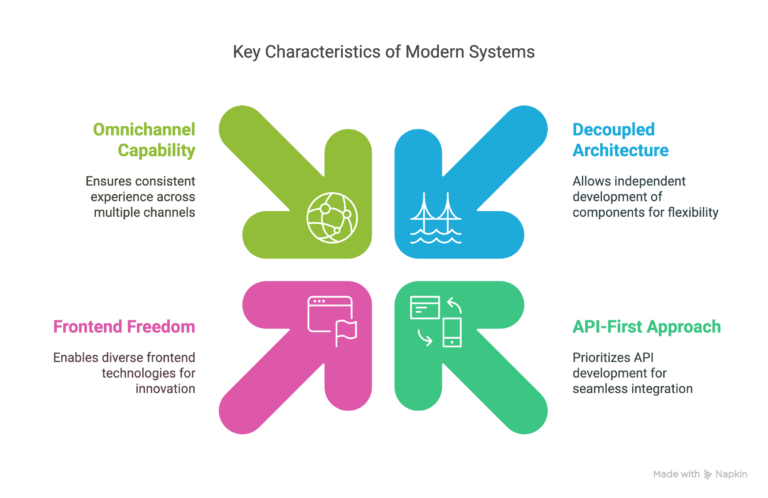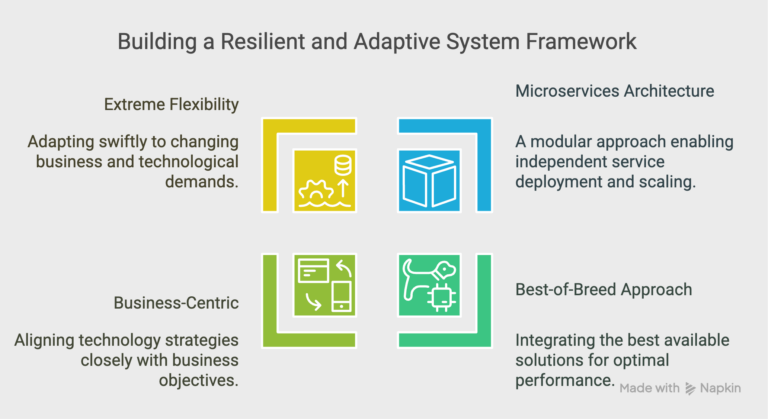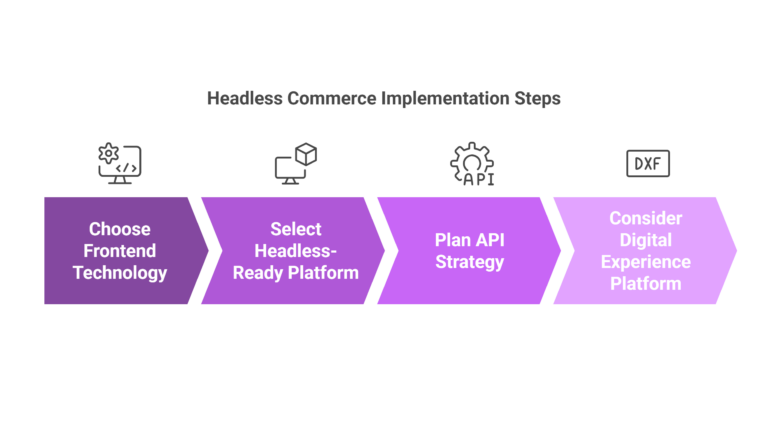Greetings! I'm Aneesh Sreedharan, CEO of 2Hats Logic Solutions. At 2Hats Logic Solutions, we are dedicated to providing technical expertise and resolving your concerns in the world of technology. Our blog page serves as a resource where we share insights and experiences, offering valuable perspectives on your queries.

Quick Summary
Headless commerce separates the frontend presentation layer from the backend commerce functionality, offering flexibility and customization. Composable commerce takes this modularity further by breaking down all commerce components into independent services that can be selected and assembled based on specific business needs. Headless is a subset of composable, which represents a more comprehensive architectural philosophy.
Ever found yourself scratching your head when someone drops terms like “headless commerce” or “composable commerce” in a meeting?
You’re not alone. In the rapidly evolving e-commerce landscape, these architectural approaches have become increasingly popular, but understanding their nuances can feel like deciphering a foreign language.
At 2Hats Logic guided dozens of businesses through digital commerce transformations, and I’ve seen firsthand how choosing the right architecture can make or break your online business strategy.
Let’s demystify these concepts and help you determine which approach aligns with your business needs.
Understanding Headless Commerce
Headless commerce refers to an architecture where the presentation layer (the “head”) is decoupled from the backend e-commerce functionality (the “body”).
Key Characteristics

Decoupled Architecture Traditional e-commerce platforms bundle the frontend and backend together. Headless separates them, connecting them through APIs.
API-First Approach APIs serve as the communication bridge between the decoupled components, enabling flexibility and integration.
Frontend Freedom Developers can create custom storefronts using any technology stack (React, Vue, Angular, etc.) without being constrained by backend limitations.
Omnichannel Capability The same backend can power multiple frontends, from websites to mobile apps, IoT devices, and even voice assistants.
Real-World Application
One of our clients, a luxury fashion retailer, was struggling with slow site performance and limited customization options on their traditional platform. After implementing a headless solution:
- Page load times decreased by 42%
- Mobile conversions increased by 31%
- They launched a progressive web app and in-store kiosks using the same backend
- Development cycles for new features shortened from weeks to days
Understanding Composable Commerce
Composable commerce takes the modular approach of headless even further. It’s built on the concept of decomposing your entire e-commerce ecosystem into individual “packaged business capabilities” (PBCs) that can be selected and assembled according to specific business needs.
Key Characteristics

Microservices Architecture Each commerce function (product catalog, cart, checkout, search, etc.) exists as an independent service that can be developed, deployed, and scaled separately.
Best-of-Breed Approach Instead of relying on a single vendor, businesses can select specialized solutions for each component from different providers.
Business-Centric The focus shifts from technical constraints to business capabilities, allowing organizations to adapt quickly to market changes.
Extreme Flexibility Components can be swapped out or upgraded individually without disrupting the entire system.
Real-World Application
A mid-sized B2B manufacturer we worked with was struggling with a monolithic platform that couldn’t support their complex pricing models and customer-specific catalogs.
Their composable commerce implementation included:
- A specialized B2B-focused product information management (PIM) system
- A custom pricing engine that handled complex contract pricing
- An enterprise search solution with advanced filtering capabilities
- A headless CMS for content management
The result? A 45% increase in customer satisfaction scores and a 28% reduction in cart abandonment rates.
Key Differences: Headless vs. Composable
Let’s break down the crucial distinctions between these two approaches:
| Feature | Headless Commerce | Composable Commerce |
|---|---|---|
| Scope | Frontend-backend separation | Complete modular architecture |
| Flexibility | High frontend flexibility | Extreme flexibility across all components |
| Implementation Complexity | Moderate | High |
| Best For | Brands focusing on frontend innovation | Businesses needing customization at every level |
| Technology Approach | API-first | API-first + microservices |
Pro-Tip: Think of headless as the first step toward composable. You can start with decoupling your frontend, then gradually decompose other commerce functions as your needs evolve.
When to Choose Headless Commerce
Headless commerce might be the right choice if:
- You need frontend flexibility but aren’t ready for a complete architectural overhaul.
A specialty food retailer we worked with wanted to create a unique shopping experience but wasn’t prepared for the complexity of a fully composable approach.
Headless gave them the frontend freedom they needed while keeping the backend relatively simple. - Your business operates across multiple channels.
A sporting goods company we consulted was able to power their website, mobile app, and in-store kiosks from the same headless backend.
This ensured consistent inventory and pricing across all channels. - You want improved performance and better user experiences.
Headless architectures can deliver content faster and provide more engaging user experiences, as they’re not constrained by traditional template systems. - You have strong frontend development capabilities.
The freedom of headless comes with responsibility, you’ll need solid frontend development resources to take advantage of it.
When to Choose Composable Commerce
Consider composable commerce when:
- You need extreme customization across all commerce functions.
A global electronics manufacturer we worked with had unique requirements for everything from product configuration to service bundling and fulfillment.
Composable allowed them to build a solution that perfectly matched their complex business model. - Your business model changes frequently.
Fashion retailers operating on a composable architecture can quickly swap out components to support new business models like rental, subscription, or secondhand sales. - You want to avoid vendor lock-in.
A composable approach allows you to select best-of-breed solutions for each component and replace individual elements without disrupting the entire system. - You have mature development and integration capabilities.
Composable requires significant technical expertise to implement and maintain effectively.
Implementation Considerations
Headless Implementation
When implementing headless commerce:

- Choose the right frontend technology: React, Vue, Angular, or Next.js are popular choices depending on your team’s expertise.
- Select a headless-ready commerce platform: Platforms like Shopify Plus, BigCommerce, and commercetools offer robust APIs for headless implementations.
- Plan your API strategy: Determine which APIs you’ll need and how they’ll be orchestrated.
- Consider a Digital Experience Platform (DXP): Many organizations pair headless commerce with a DXP for content management.
Composable Implementation
For composable commerce:

- Map your business capabilities: Identify all the commerce functions you need and prioritize them.
- Create a phased approach: Start with core components and gradually add more specialized capabilities.
- Invest in integration infrastructure: API management, event buses, and integration platforms are essential.
- Build a strong DevOps practice: Continuous integration/continuous deployment (CI/CD) pipelines are crucial for managing multiple microservices.
Real-World Lessons Learned
Through our agency’s experience implementing both headless and composable solutions, we’ve learned:
- Start small, think big: Begin with a proof of concept that addresses a specific business challenge.
- Budget for integration: The most significant costs often come from integrating various components.
- Don’t underestimate the organizational impact: Both approaches require new ways of working and thinking.
- Performance requires attention: With more moving parts, performance optimization becomes more complex but even more critical.
Future Trends
As we look ahead, several trends are shaping the evolution of headless and composable commerce:
- API-as-a-Product: Commerce APIs are becoming products in themselves, with more robust documentation, developer tools, and support.
- Composable Experience Layers: The frontend is evolving into its own composable ecosystem with reusable components.
- AI-Driven Composition: Artificial intelligence is beginning to help orchestrate and optimize composable systems dynamically.
- Low-Code Composition Tools: New tools are emerging that make composable commerce more accessible to businesses without extensive development resources.
Pro-Tip: When evaluating commerce technology vendors, look beyond current capabilities to their API roadmap and ecosystem of partners. The strength of their API strategy often indicates their future-readiness.
Making the Right Choice for Your Business
The decision between headless and composable isn’t binary it’s a spectrum. Many businesses start with headless and gradually move toward a more composable approach as their needs evolve.
Consider:
- Business complexity: How unique and complex are your commerce requirements?
- Technical capabilities: What level of technical expertise do you have in-house or through partners?
- Growth trajectory: How rapidly is your business changing, and what flexibility will you need in the future?
- Budget and timeline: What resources can you allocate to this transformation?
Conclusion
The distinction between headless commerce vs composable commerce represents a critical decision point for modern digital businesses.
Headless commerce offers frontend flexibility through API-based decoupling, while composable commerce extends this philosophy to create fully modular, best-of-breed ecosystems across all commerce capabilities.
At 2HatsLogic, we’ve helped dozens of businesses design and implement the right architecture for their unique needs.
Ready to transform your digital commerce strategy? Let our experts guide you through every step of the journey, from assessment to implementation. Talk to Our Commerce Architects
FAQ
Is headless commerce the same as composable commerce?
No. Headless is a subset of composable, focused specifically on separating the frontend from the backend.
Which approach is more cost-effective?
Headless typically requires less initial investment than fully composable solutions.
Can small businesses benefit from these approaches?
Yes, especially headless, which can be implemented incrementally with platforms like Shopify Plus.
How long does implementation typically take?
Headless projects often take 3-6 months, while composable implementations can take 6-12+ months depending on complexity.

Related Articles






